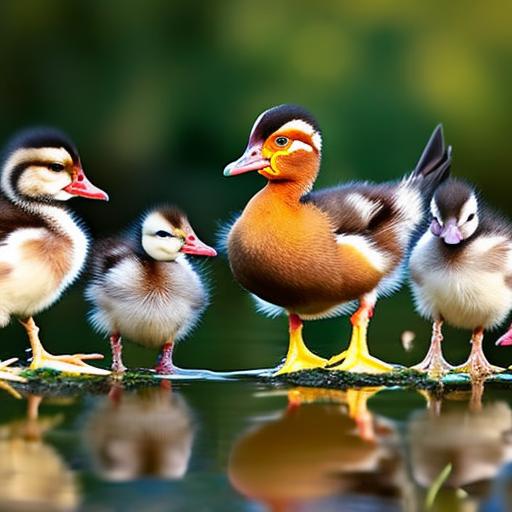Raising chickens and ducklings can be a rewarding and enjoyable experience. Both chickens and ducks are popular choices for backyard poultry enthusiasts due to their ability to provide fresh eggs, pest control, and entertainment. While they have their differences, keeping chickens and ducklings together can be beneficial for several reasons. In this article, we will explore the benefits of raising a mixed flock, understand the differences between chickens and ducklings, learn how to choose the right breeds, create the perfect habitat, feed and water your flock, manage their health and hygiene, train them to coexist peacefully, and address common challenges that may arise.
Key Takeaways
- Raising chickens and ducklings together can be a rewarding experience for backyard farmers.
- Chickens and ducklings have different needs and behaviors, but can coexist peacefully with proper management.
- Choosing the right breeds for your mixed flock is important to ensure compatibility and productivity.
- Creating a suitable habitat with adequate space, shelter, and access to food and water is crucial for the health and well-being of your flock.
- Proper feeding, watering, hygiene, and health management are essential for maintaining a healthy and happy mixed flock.
Benefits of Keeping Chickens and Ducklings Together
One of the main benefits of keeping chickens and ducklings together is natural pest control. Chickens are known for their ability to scratch and peck at the ground, which helps control insects and pests in your yard or garden. Ducks, on the other hand, are excellent at eating slugs, snails, and other pests that may be present in your outdoor space. By keeping both chickens and ducklings together, you can have a natural pest control team that will help keep your yard free from unwanted critters.
Another benefit of raising a mixed flock is their complementary diets. Chickens primarily eat grains, seeds, insects, and kitchen scraps. On the other hand, ducks are omnivorous and enjoy a diet that includes insects, worms, snails, slugs, aquatic plants, and grass. By allowing them to forage together, they can help each other find a variety of food sources. This can also help reduce feed costs as they will be able to find some of their food naturally.
Furthermore, keeping chickens and ducklings together can provide entertainment value. Both species have unique behaviors that can be fascinating to observe. Chickens are known for their scratching and pecking behavior, while ducks are known for their swimming and dabbling in water. Watching them interact and go about their daily activities can be a source of joy and amusement for poultry enthusiasts.
Understanding the Differences Between Chickens and Ducklings
While chickens and ducklings have some similarities, they also have distinct physical, behavioral, and communication differences. Understanding these differences is important when raising a mixed flock.
Physically, chickens have feathers that are more compact and tightly packed, while ducks have feathers that are looser and more water-resistant. Chickens have claws on their feet that are adapted for scratching the ground, while ducks have webbed feet that are designed for swimming. Additionally, chickens have a beak that is straight and pointed, while ducks have a beak that is broad and flat.
Behaviorally, chickens are more terrestrial and prefer to spend their time on land. They scratch the ground to find food and enjoy perching on roosts. Ducks, on the other hand, are more aquatic and enjoy spending time in water. They love to swim, dabble, and splash around. Ducks also have a strong instinct to migrate and may attempt to fly away if not properly contained.
In terms of communication, chickens make a variety of sounds including clucking, crowing, and squawking. They use these sounds to communicate with each other and to alert the flock of potential danger. Ducks, on the other hand, make a range of vocalizations including quacking, whistling, and hissing. They use these sounds to communicate with each other and to express their emotions.
Choosing the Right Breeds for Your Flock
When choosing breeds for your mixed flock, there are several factors to consider. First, you need to consider the climate in your area. Some breeds of chickens and ducks are better suited for cold climates, while others are better suited for hot climates. It’s important to choose breeds that can thrive in the conditions you provide.
Second, you need to consider the size of your flock and the space you have available. Some breeds of chickens and ducks are larger and require more space, while others are smaller and can be kept in smaller areas. It’s important to choose breeds that will be comfortable in the space you provide.
Third, you need to consider the purpose of your flock. If you are primarily interested in egg production, you may want to choose breeds that are known for their egg-laying abilities. If you are interested in meat production, you may want to choose breeds that are known for their meat quality. If you are interested in both eggs and meat, you may want to choose dual-purpose breeds.
Recommended breeds for mixed flocks include the Australorp chicken, which is a good layer and can tolerate both hot and cold climates. The Orpington chicken is another good choice as it is a calm and friendly breed that gets along well with ducks. For ducks, the Khaki Campbell is a popular choice as it is a good layer and can adapt well to different climates. The Pekin duck is also a good choice as it is a large breed that is known for its meat quality.
Creating the Perfect Habitat for Chickens and Ducklings
Creating the perfect habitat for your mixed flock is essential for their health and well-being. Both chickens and ducklings have specific requirements that need to be met.
For the coop and run, chickens require a secure and predator-proof structure that provides adequate ventilation, light, and space. The coop should have roosting bars for chickens to perch on at night, as well as nesting boxes for them to lay their eggs. The run should be spacious enough for chickens to move around and scratch the ground.
Ducks require a different setup as they need access to water for swimming and dabbling. They also need protection from predators, so a secure enclosure is necessary. Ducks can be kept in a coop with a small pool or pond, or they can be provided with a separate water source such as a kiddie pool or a pond in the yard.
For nesting boxes and bedding, chickens prefer nesting boxes that are dark, quiet, and private. They like to lay their eggs in a secluded area away from the rest of the flock. Bedding material such as straw or wood shavings should be provided to keep the nesting boxes clean and comfortable.
Ducks, on the other hand, do not require nesting boxes as they prefer to lay their eggs in hidden spots on the ground or in tall grass. However, they do require bedding material in their coop to provide insulation and comfort. Straw or wood shavings can be used as bedding for ducks.
Feeding and Watering Your Mixed Flock

Feeding and watering your mixed flock requires careful consideration of their dietary needs and preferences.
Both chickens and ducks require a balanced diet that includes protein, carbohydrates, fats, vitamins, and minerals. Commercial poultry feed is available for both species and provides the necessary nutrients. However, it’s important to choose the appropriate feed for each species as their nutritional requirements may differ slightly.
Chickens can be fed a layer feed that is specifically formulated for egg-laying hens. This feed contains higher levels of calcium to support egg production. Ducks can be fed a poultry feed that is suitable for all-purpose use. It’s important to avoid feeding ducks layer feed as it contains too much calcium for their needs.
In addition to commercial feed, both chickens and ducks can be given kitchen scraps such as fruits, vegetables, and grains. It’s important to avoid feeding them anything that is toxic or harmful to their health. It’s also important to provide fresh water at all times for both species.
For ducks, it’s important to provide them with access to water for swimming and dabbling. This can be done by providing a small pool or pond in their enclosure. Ducks enjoy splashing around in the water and it helps keep their feathers clean and healthy.
Managing Health and Hygiene for Your Chickens and Ducklings
Managing the health and hygiene of your mixed flock is crucial to prevent diseases and ensure their well-being.
Common health issues that can affect chickens include respiratory infections, parasites, and egg-related problems. It’s important to provide a clean and dry environment for chickens to prevent respiratory issues. Regular deworming and checking for external parasites such as mites and lice is also important. Egg-related problems such as egg binding or soft-shelled eggs can occur in chickens and may require veterinary intervention.
Ducks are generally hardy birds but can be susceptible to respiratory infections, parasites, and foot problems. Providing a clean and dry environment is important to prevent respiratory issues in ducks as well. Regular deworming and checking for external parasites is also necessary. Foot problems such as bumblefoot can occur in ducks and may require treatment.
Cleaning and maintaining the coop and run is essential for the health of your mixed flock. Regularly removing droppings, replacing bedding material, and disinfecting the coop can help prevent the spread of diseases. It’s also important to provide proper ventilation to prevent moisture buildup, which can lead to respiratory issues.
Regular health checks are important to monitor the overall well-being of your mixed flock. This includes checking for any signs of illness or injury, monitoring their weight, and observing their behavior. If you notice any abnormalities or concerns, it’s important to seek veterinary care.
Training Your Flock to Coexist Peacefully
Training your mixed flock to coexist peacefully requires patience, consistency, and proper introduction techniques.
When introducing new birds to the flock, it’s important to do so gradually. This can be done by keeping the new birds in a separate enclosure within sight of the existing flock. This allows them to become familiar with each other without direct contact. After a period of time, the new birds can be introduced to the existing flock under supervision.
Encouraging peaceful interactions between chickens and ducklings can be done by providing plenty of space and resources. This includes providing multiple feeding and watering stations, as well as multiple roosting areas. This helps prevent competition and reduces the likelihood of aggressive behavior.
Addressing aggressive behavior is important to maintain a peaceful flock. If you notice any signs of aggression, such as pecking or chasing, it’s important to intervene and separate the birds if necessary. Providing distractions such as toys or treats can also help redirect their attention and reduce aggression.
Common Challenges When Keeping Chickens and Ducklings Together
Keeping chickens and ducklings together can come with its challenges. It’s important to be aware of these challenges and have strategies in place to address them.
One potential challenge is conflicts between species. Chickens and ducks have different behaviors and communication styles, which can sometimes lead to misunderstandings or conflicts. It’s important to monitor their interactions and intervene if necessary to prevent any harm.
Managing mess and odor can also be a challenge when keeping chickens and ducklings together. Ducks produce more waste than chickens, especially in their water source. Regular cleaning of the coop and run is necessary to prevent odors and maintain a clean environment.
Dealing with predators is another challenge that poultry owners may face. Both chickens and ducks are vulnerable to predators such as raccoons, foxes, and hawks. It’s important to provide secure enclosures and predator-proof fencing to protect your flock. Additionally, providing adequate shelter and cover can help reduce the risk of predation.
Enjoying the Rewards of a Mixed Flock
Raising a mixed flock of chickens and ducklings can be a rewarding and enjoyable experience. The benefits of natural pest control, complementary diets, and entertainment value make it a worthwhile endeavor. By understanding the differences between chickens and ducklings, choosing the right breeds, creating the perfect habitat, feeding and watering your flock, managing their health and hygiene, training them to coexist peacefully, and addressing common challenges, you can create a harmonious and thriving mixed flock. So why not give it a try and enjoy the rewards of raising chickens and ducklings together?
If you’re considering keeping chickens and ducklings together, it’s important to understand the dynamics and requirements of both species. While they can coexist harmoniously, there are certain considerations to keep in mind. One crucial aspect is providing adequate heating for your chicken coop during colder months. To learn more about this topic, check out this informative article on the benefits of using a heater for a chicken coop. Additionally, if you’re in the process of building or upgrading your chicken coop and run, you may find these comprehensive chicken coop run plans helpful. Lastly, if you’re wondering whether geese can eat chicken feed, this article provides insights into the dietary needs of geese and whether they can safely consume chicken feed.
FAQs
What are the differences between chickens and ducklings?
Chickens and ducklings are different in terms of their physical characteristics, behavior, and dietary needs. Chickens have feathers that are more compact and oily, while ducklings have fluffier feathers that are more water-resistant. Chickens are more ground-dwelling and prefer to scratch and peck at the ground, while ducklings are more aquatic and enjoy swimming and splashing in water. Chickens are omnivores and primarily eat grains and insects, while ducklings are more herbivorous and prefer to eat aquatic plants and insects.
Can chickens and ducklings be kept together?
Yes, chickens and ducklings can be kept together as long as they are introduced to each other at a young age and have enough space to coexist peacefully. It is important to provide separate feeding and watering stations for each species, as well as separate nesting areas. Chickens and ducklings also have different temperature requirements, so it is important to provide a warm and dry shelter for the ducklings.
What are the benefits of keeping chickens and ducklings together?
Keeping chickens and ducklings together can provide several benefits, such as increased pest control, improved soil health, and more efficient use of space. Chickens and ducklings both eat insects and other pests, which can help reduce the need for chemical pesticides. Their manure also provides valuable nutrients for plants and can help improve soil health. Additionally, keeping both species together can help maximize the use of space in a backyard or small farm.
What are the potential drawbacks of keeping chickens and ducklings together?
One potential drawback of keeping chickens and ducklings together is that they have different dietary needs and may compete for food. Chickens may also peck at the ducklings, which can cause injury or stress. Additionally, ducklings require more water than chickens and may make a mess of the water source, which can create unsanitary conditions. It is important to monitor the behavior of both species and provide adequate resources to prevent any negative interactions.
What are some tips for keeping chickens and ducklings together?
To successfully keep chickens and ducklings together, it is important to introduce them to each other at a young age and provide adequate space and resources. Separate feeding and watering stations should be provided for each species, as well as separate nesting areas. It is also important to monitor the behavior of both species and intervene if any negative interactions occur. Providing a warm and dry shelter for the ducklings is also essential, as they have different temperature requirements than chickens.
Meet Walter, the feathered-friend fanatic of Florida! Nestled in the sunshine state, Walter struts through life with his feathered companions, clucking his way to happiness. With a coop that’s fancier than a five-star hotel, he’s the Don Juan of the chicken world. When he’s not teaching his hens to do the cha-cha, you’ll find him in a heated debate with his prized rooster, Sir Clucks-a-Lot. Walter’s poultry passion is no yolk; he’s the sunny-side-up guy you never knew you needed in your flock of friends!







